|
|
Post by another specialist on Dec 31, 2006 16:34:09 GMT
The rock wren had once 3 subspecies today all are gone. Xenicus longipes longipes This was once a very common bird on South Island or at least before the europeans arrived. By 1950 it had become extremly rare and the last record was in January 1968 when 2 birds was seen in Nelson lakes national park. |
|
|
|
Post by another specialist on Dec 31, 2006 16:37:08 GMT
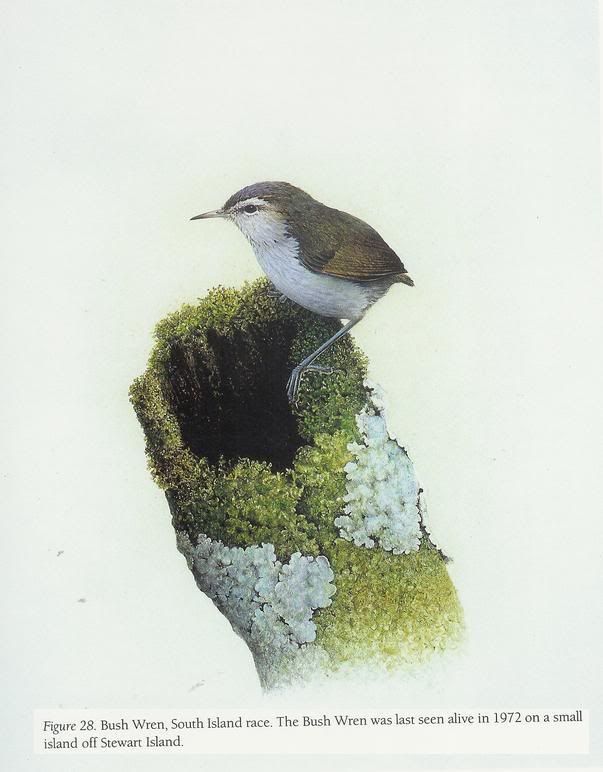 New Zealand Extinct Birds Brian Gill and Paul Martinson |
|
|
|
Post by another specialist on Dec 31, 2006 16:40:11 GMT
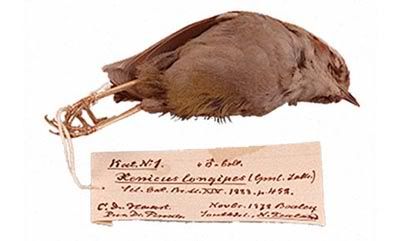 The museum collection The specimen in the National Museum of Natural History is the South Island form longipes. It was collected in the 1870's by Sir John Francis Julius von Haast, after whom a town on South Island has been named. Apparently, von Haast had given the skin to Otto Finsch, who donated it to the Leiden Museum. 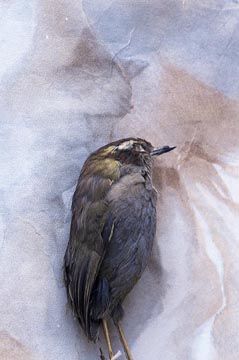 www.naturalis.nl/300pearls/ www.naturalis.nl/300pearls/ |
|
|
|
Post by another specialist on Dec 31, 2006 16:44:11 GMT
Xenicus longipes and Xenicus gilviventris The narrow tracks of the island (Kotiwhenu) originally hewn out by "birders" for their own purpose and from time to time opened afresh, these paths were a boon to us both for convenience of travel and as woodland rides, across which no creature could pass without observation. It was in the light admitted by one of them that a tiny unknown bird fluttered its feeble way late in the afternoon of our first day. About the size of the wren of the Old Country, and as inconspicuous in appearance, the small stranger proved on further acquaintance to be the bush wren of New Zealand. I waited to see more of the stranger whose proximity could be detected by stir of the vegetation into which it had pitched shivering of fronds, rustle of rough sedge. After many momentary, tantalising glimpses of the bird, which was feeding in company with a mate - I could hear them talking - one of the pair crossed the path, affording a good view, and corroborating what I had suspected as to species. A few minutes later the second bird, evidently the male, followed, and at once became engaged in warfare with another male, these Lilliputans fighting only a few yards from the tree trunk against which I stood. There was something in the air of the victor and in the determination with which he hustled the trespasser of his domain which showed how keen was his desire for seclusion. In the bird world, too, there are vested interests, and the tenacity with which an owner will uphold his rights usually gives him the victory in anything like an even match. I judged there must be some special reason for my small companion's wrath, and I was right, for by the time my mates had boiled the billy I had thrice noticed one of the pair disappear beneath a particular iron-wood bole. The locality was close to our hut, and during the next two or three days all odd quarter hours and half hours were devoted to the observations and movements of these particular wrens. Thus we discovered there was certainly a pair, male and female, equally often to be found near the great log. Later again we were able to ascertain a certain route constantly followed. At last one evening I spotted one of the pair bearing a feather in its beak flutter up into the gloom of a frond-hung trunk. Nests of the bush wren are unusually difficult of detection, the openings into them even in good light almost imperceptible. Of the three nests discovered, not one of them was as we had imagined it might be. The first was built somewhere within the mouldering bulk of a huge fallen ironwood already mentioned. Half-way down its dark side, corded thickly with the brown-green vigorous roots of the spotted polypod, was the entrance to the nest. So small was it, even when compared to the size of the little builders, that they could scarcely enter, always having to haul themselves in by many minute, grasping, scrambling movements. The edges of the circular hole, shaded by great dark overlapping fronds, were firmly bound with fibre collected from the durable cores of fallen tree ferns, its dull blue-black hue matching exactly the rooty coating of the log. The ingress to our second nest was even more difficult to determine. It was actually down a petrel's burrow, an earthy cavern scraped out like a rabbit hole, a vestibule whose disproportionate size made utilisation seem impossible. Although, repeatedly, the wren was lost to sight in its proximity, none of us could credit that so small a creature would enter its nesting quarters by so vast a cavity. The petrel passage was not, however, followed far, the wren relinquishing it for some infinitesimal tunnel passing upwards into the roots of the fern clump which thereabouts covered many yards of ground. A third nest was found in the rotting centre of a half-dead green tupari - a small tree which in its fall had been wrenched and twisted, and was seemed with longitudinal cracks. Nothing at first did more to mislead us than the wren's toleration for dampness in its nesting site. With most species dryness is a prime consideration: hollows, holes, and crannies in the least degree moist or clammy are eschewed. Wetness is impossible always to avoid but nearly all species secure as perfect drainage as possible, in rainy districts even seeming to select vegetation that rapidly dries itself. No one. however, of the three nesting sites described was other than damp; one was actually wet. After every shower, into the nest of the ironwood bole, dry feathers were carried in and wet feathers taken out; after every shower in the nest built amongst the fern roots, wet feathers were replaced by dry. The nest in the Tupari trunk was the most sodden of all, pressed, as it were, against green wet wood. reached by a long moist hollow way, and with stagnant water lying within a few inches of the eggs. Into it also dry feathers were carried, and from it wet feathers removed. The conversational note of the birds amongst the low vegetation, where their lives are passed, is a faint rasping sound, the noise of a small wrist-watch in process of winding. When excited or alarmed they utter a loud cheep. At the distance of only a few feet, many hours were spent pleasantly, if not profitably, speculating as to the why and wherefore of the lives of these little wrens and as to the enormous terrestrial changes that has forced innovation upon such tiny creatures. The activities of the breed are altogether restricted to movements two or three feet from the ground. They never stray more than a few yards from the tangle where safety lies. Even when close to his own nest, I have watched the male wait and hesitate unable to harden his heart sufficiently to dare to make a forward movement. The lives of the little harmless fellows are overshadowed by an enduring dread - the dread of the robin. Passing from log to log, taking cover beneath each gloomy bole, they listen for the snap of its terrible mandibles; they cower before its swoop. They are at least as active, however, on their legs as on their wings. The hop of the bush wren is a remarkable performance. During the first salutary movement the bush wren carries himself parallel to the earth; at the termination, however, of each leap he telescopes upwards on his toes, momentarily erecting himself in the oddest way to his full height. When the two movements are blended in rapid action, what with his whitish feet, short toes and long thin legs, and tightly folded body plumage, he resembles in no small degree a barefooted bairn running on sands with tucked-up garments firmly fastened around the waist. He passes through the darkling underscrub like a forest gnome, like a woodland brownie. In the island wren we may see perchance a minute example of the pressure of a species one upon the other in a congested area. We can picture the wren as he was and as he is. By a very limited exercise of imagination we may visualise him, not confined as now to a few acres on a tiny island, but ranging over the forests of a mainland; not laying a clutch of two eggs, the sign of a failing, or at any rate of a curtailed, food supply; his choice of building sites not relegated to damp chinks and cracks; his domed nest not built in the dark; his flight not limited to a flutter of a few yards; himself during incubation not forbidden the warm precincts of the natural day. Abridged from Guthrie-Smith's Birdlife on Island and Shore, 1925. Note: The extinction of these wrens is directly attributable to the arrival of ship rats at Kotwhenu and Big South Cape Islands in the early 1960s. The birds: a thriller made in NZ Thursday July 22, 2004 The Guardian The DNA clock is a complex timepiece: measure the changes in a length of DNA common to a large group of creatures and you will get a clue not just to the network of evolutionary relationships, but to the whole family tree. Keith Barker, of the University of Minnesota, and colleagues report in the Proceedings of the National Academy of Sciences that they studied the lineages of the Passeriformes or perching birds to arrive at a kind of pecking order of seniority. There are 5,739 of these songbirds - crows, starlings, thrushes, robins, tanagers, mockingbirds, jays and so on - on all the continents except Antarctica. Near the root of the Passeriforme tree, they report, are the Acanthisittidae, or New Zealand wrens. The implication is that the first passerines evolved in the Cretaceous era, somewhere near what is now New Zealand, and spread their wings with the break-up of the old Gondwana continent, from Australasia to Eurasia, Africa and the New World. In the course of this, they came to comprise "nearly half of all extant avian species, and represent the largest identifiable radiation of birds, encompassing a staggering ecological and behavioural diversity". Maori name: Matuhi source for info for entry Re: New Zealand wrens « Reply #3 on Jun 4, 2005, 9:51am » www.nzbirds.com/Matuhi.html |
|
|
|
Post by another specialist on Dec 31, 2006 16:46:08 GMT
The Bush Wren (''Xenicus longipes''), or Matuhi in Maori, is a very small and almost flightless bird endemic to New Zealand. It grows to about 9 cm long and 16 g in weight. It feeds mostly on invertebrates which it captures by running along the branches of trees. It nests on or near the ground. It was widespread throughout the main islands of the country until the late 1800s when mustelids were introduced and joined rats as predators. The only authenticated reports of the North Island subspecies (''X. l. stokesi'') since 1900 were from the southern Rimutaka Range in 1918 and the Urewera Ranges up to 1955. The last authenticated reports of the South Island subspecies (''X. l. longipes'') were from Arthur’s Pass in 1966 and Nelson Lakes National Park in 1968. There have been a few unsubstantiated reports since then from Fiordland and Nelson Lakes. The third subspecies, X. l. variabilis or Stead’s Bush Wren, was found on Stewart Island and nearby islands. It is known to have survived on Stewart Island until 1951 but was probably exterminated by feral cats. It lived on Kotiwhenua (Solomon) Island until the early 1960s. It survived on predator-free Big South Cape Island until Black Rats invaded it in 1964. The New Zealand Wildlife Service attempted to save the species by relocating all the birds they could capture. They caught six birds and transferred them to Kaimohu Island where they were last seen in 1972. The species is probably extinct but it is not beyond possibility that it survives. Category:Passeriformes category:New Zealand birds category: Extinct birds fr:Xénique des buissons www.answers.com/topic/bush-wren |
|
|
|
Post by another specialist on Dec 31, 2006 16:47:57 GMT
 Bush wren North Island bush wren Xenicus longipes stokesi South Island bush wren Xenicus longipes longipes The bush wren was the fourth New Zealand wren extinction. The last recorded sighting of the North Island subspecies Xenicus longipes stokesi was in the Te Urewera Range in 1955. The South Island subspecies Xenicus longipes longipes was last sighted in Nelson Lakes National Park in 1968 and Kaimohu Island off Stewart Island in 1972. Both of these subspecies are also known as the New Zealand bush wren. www.terranature.org/wren.htm |
|
|
|
Post by another specialist on Dec 31, 2006 16:53:02 GMT
The extinction of all thre subspecies of Xenicus longipes is an specially sad story, involving such handsome creatures wiped out by introduced rats and stoats. Some of the links to images in previous posts of this thread seem that no longer work. So I've scanned the images of all three from books in my library and I'm posting them for everybody's benefit: South Island Bush Wren ( Xenicus longipes longipes) 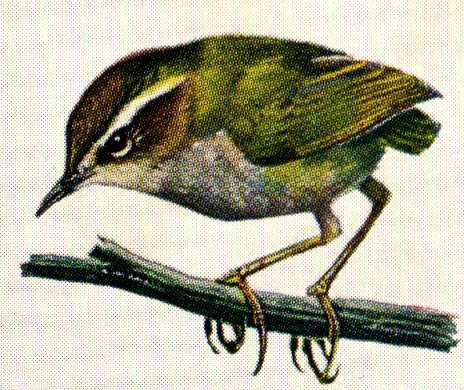 Beautiful illustration by Chloe Talbot Kelly in Plate 17 of Falla, Sibson & Turbott (1960): A Field Guide to the Birds of New Zealand  Arthur Singer's artwork in Austin & Singer (1961): Birds of the World |
|
|
|
Post by another specialist on Dec 31, 2006 17:03:56 GMT
 gap in nature |
|
|
|
Post by another specialist on Dec 31, 2006 17:04:41 GMT
|
|
|
|
Post by another specialist on Apr 30, 2008 19:23:10 GMT
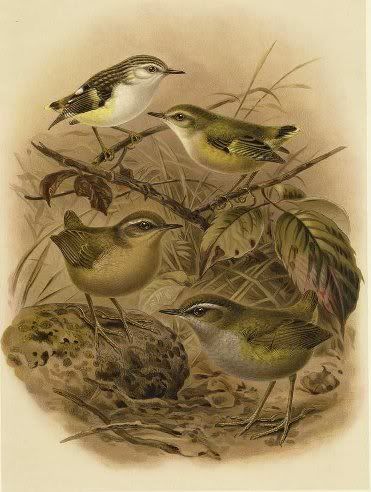 (Acanthidositta chloris) (Xenicus gilviventris)(Xenicus longipes) www.kersti.de |
|
|
|
Post by Carlos on May 16, 2008 16:11:32 GMT
The extinction of all thre subspecies of Xenicus longipes is an specially sad story, involving such handsome creatures wiped out by introduced rats and stoats. Some of the links to images in previous posts of this thread seem that no longer work. So I've scanned the images of all three from books in my library and I'm posting them for everybody's benefit: South Island Bush Wren ( Xenicus longipes longipes)  Beautiful illustration by Chloe Talbot Kelly in Plate 17 of Falla, Sibson & Turbott (1960): A Field Guide to the Birds of New Zealand  Arthur Singer's artwork in Austin & Singer (1961): Birds of the World Please, Frank, if you rearrange the posts in new boards (like this one for the second time), please, at least do mention the person that posted it at first (in this instance myself), otherwise it wouldn't be fair  |
|
|
|
Post by another specialist on May 16, 2008 21:05:32 GMT
Sorry Carlos just doing my job of splitting and merging and moderating this forum.
But point taken.
Next time just PM me.
|
|
|
|
Post by Melanie on Jul 12, 2008 22:08:29 GMT
Xenicus Longipes. (Bush-Wren.)
Long-legged Warbler, Lath. Gen. Syn. ii. pt. 2, p. 465 (1783).
Motacilla longipes, Gm. Syst. Nat. i. p. 979 (1788, ex Lath.).
Sylvia longipes, Lath. Ind. Orn. ii. p. 529 (1790).
Acanthisitta longipes, Gray, List of Gen. of Birds, App. p. 6 (1841).
Xenicus longipes, Gray, Ibis, 1862, p. 218.
Xenicus stokesii, id. tom. cit. p. 219.
Native names.
Matuhituhi, Piwauwau, Puano, and Huru-pounamu.
? pileo umbrino: dorso toto viridi, uropygio lætiore: supercilio distincto albo: plumis anteocularibus nigris:
regione paroticâ brunneâ vix viridi lavatâ: tectricibus alarum dorso concoloribus, vix flavido tinctis: alâ
spuriâ nigrâ: remigibus brunneis, extùs olivaceo-viridi lavatis: caudâ suprà olivaceo-viridi, subtùs
flavicante: mento albido: corpore reliquo subtùs pulchrè cinereo, pectore vix argenteo-nitente: abdomine
imo et subcaudalibus viridibus, hypochondriis olivaceo-flavis: cruribus brunneis: subalaribus et margine
alari pallidè citrinis: rostro saturatè brunneo: pedibus flavicantibus.
? dissimilis: suprà ferrugineo-brunnea: uropygio vix olivaceo tincto: supercilio lato albo: subtùs pallidè
chocolatina, hypochondriis et abdomine imo sordidè flavis.
Adult male. Upper parts dark green, tinged with yellow, shading into dark brown on the forehead and
crown; sides of the head black, with a broad superciliary streak of white extending beyond the ears, and
then changing to yellow; sides, thighs, and rump bright greenish yellow; fore neck, breast, and abdomen
cinereous grey, with a beautiful gloss (sometimes tinged with cobalt), and softening into greyish white on
the throat; lining of wings pale yellow; quills, on their outer webs, and the tail-feathers olivaceous green.
Irides and bill brownish black; tarsi and toes pale brown. Extreme length 4 inches; wing, from flexure,
2·26; tail 1 (more than half of it concealed by the soft coverts); bill, along the ridge ·5, along the edge of
lower mandible ·7; tarsus 1; middle toe and claw ·9; hind toe and claw ·8.
Adult female. Upper parts umber-brown, tinged with yellowish green, especially on the rump; crown
shaded with purplish brown; superciliary streak white; throat, sides of the neck, breast, and upper part of
abdomen delicate vinous brown; sides of the body, flanks, and thighs dull lemon-yellow; inner lining of
wings pure yellow. silky grey of the breast tinged with purple; crown of the head and hind part of neck chocolate-brown,
blending into the olvaceons green of the upper parts; superciliary streak broad and conspicuous.
Obs. The figure of X. longipes in the ‘Voyage of the Erebus and Terror,’ which represents a bird with a
white eye-circlet and an upturned bill like that of Acanthidositta , is copied from a rough half-finished
drawing of Forster's (1777) and is strikingly incorrect. Professor Hutton, whose views are entitled to
respect, wrote thus, after the appearance of my former edition:—“Dr. Buller obtained specimens of X,
stokesii which he wrongly determined as X. longipes ; in fact all the specimens of X. longipes in his
collection were X. stokesii ; these he compared with X. stokesii in the British Museum, and naturally
found them identical. But until it is explained how it is that the figure and description of X. longipes in the
‘Voyage of the Erebus and Terror’ differ so much from specimens of X. stokesii , I must continue to
regard them as two species” (‘Ibis,’ 1874, p. 37). A specimen, however, labelled by Prof. Hutton “
Xenicus stokesii, female,” and sent to Dr. Finsch for examination, was referred by this naturalist, without
hesitation, to X. longipes , Gmelin. It is perfectly clear that X. stokes has no existence as a species.
Thisspecies is confined to the Fagus -forests which clothe the sides of our subalpine ranges in the South
Island, never being met with in the low country. In many parts of the Nelson provincial district it is quite
abundant, but only in the dense bush. In the dark forest lying between Wallis-head and Tophouse, also
along the wooded banks of the Pelorous river, it is said to be very plentiful, and even in the Fagus
-covered hills in the vicinity of Nelson it is a comparatively common bird, although less numerous now
than formerly. Mr. Travers found it numerous in the Spencer ranges (Nelson) at an elevation of 3000
feet; Sir J. Hector obtained specimens in the high wooded lands of Otago, where, as he informs me, it
was a very rare bird; Sir J. von Haast met with it frequently during his exploration of the interior of the
Canterbury district; and I observed it in the high wooded ranges forming the inland boundary of
Westland. The localities I have enumerated are all in the South Island. There are specimens, however, in
the British Museum which are said to have been obtained by Captain Stokes in the Rimutaka ranges (in
the provincial district of Wellington); and although I never met with the species in that district, or, indeed,
in any part of the North Island, an intelligent Maori, to whom I showed a coloured drawing of the bird,
appeared at once to recognize it. He said that he had often seen it in the Ruahine mountains, and that
during severe winters it sometimes appeared in the low country; and he further spoke of the plumage as
being “like silk,” an expression so aptly descriptive of its peculiar softness, that I believe the man was
quite familiar with the bird.
The Maoris have a saying that if you kill this bird “ka panga te huka” (or, “snow will fall”).
It is generally met with singly or in pairs, but sometimes several are associated, attracting notice by the
sprightliness of their movements. They run along the boles and branches of the trees with restless activity,
peering into every crevice and searching the bark for the small insects, chrysalids, and larvæ on which
they feed. It is generally arboreal in its habits, seldom being seem on the ground, in which respect it
differs conspicuously from the closely allied species, Xenicus gilviventris . It has a weak but lively note,
the sexes always calling to each other with a subdued trill, and its powers of flight are very limited.
On comparing my specimens of this bird with the type of Mr. G. R. Gray's Xenicus stokesii in the
British Museum, I feel satisfied that they are referable to one and the same species, the difference of
plumage being only sexual.
In June 1882 the late Mr. W. A. Forbes made a communication to the Zoological Society, showing,
from an investigation of their anatomy, that Xenicus and Acanthisitta (rectius Acanthidositta ), hitherto
supposed to be allied to Certhia and Sitta , were in reality mesomyodian forms, the discovery of such
low types among the Passerine birds in New Zealand being a fact of considerable interest in zoo-geographic distribution. The characters pointed out by this able investigator
*The following is extracted from the paper referred to:—
“The subjoined drawings of the syrinx of Xenicus —with which in all points Acanthisitta appears to
agree in every essential respect—will show that it has none of the complex nature of that organ in the
Oscines, the thin lateral tracheal muscle terminating on the upper edge of a somewhat osseous box
formed by the consolidation of the last few tracheal rings, and there being uo other intrinsic syringeal
muscle whatsoever. The box has a well-developed antero-posterior pessular piece. The bronchial rings
are throughout of quite simple form, and are separated by but narrow intervals. None are modified in
form to serve for the insertion of a vocal muscle, as the latter terminates higher up, as already described,
on the tracheal box, and therefore quite out of the region of the bronchi.
“The lateral position of the single syringeal muscle is that characteristic of all the Mesomyodian Passeres,
though in most of these it terminates on one of the bronchial rings, and not, as in the birds under
consideration, on the sides of the trachea. This may easily be seen by comparing the accompanying
flgures of Xenicus with the beautiful series given by Johannes Müller of the syrinx of many of the
Neotropical Mesomyodi, with those of Garrod of Pitta , or my own of Eurylamms, Oymbirhynchus ,
and Philepitta . In fact it resembles rather that of Todus , as lately described and figured by myself.
Externally the non-oscine nature of Xenicus and Acanthisitta is at once proclaimed by the structure of
their wings, which have a ‘first’ (tenth) primary nearly as long as the preceding one, and by the
non-bilaminate tarsus. The latter is covered almost completely by a single large scute, with only some
very obsolete traces of transverse division below, whilst behind its edges are contiguous for the greater
length of the tarsus, leaving only small areas at each end of that bone, which are covered by very small
scutellæ of irregular form. The digits are slender and compressed, the foot being slightly syndactyle by the
union of the fourth toe to the third for the greater part of its two most basal joints. The tail is short and
weak; and there are only ten rectrices in each of my specimens. [This is the normal number.] In all other
points, Xenicus and Acanthisitta conform to the general Passerine type. There is no trace of a plantar
vinculum . The tendor patagii brevis has the peculiar arrangement characterizing the Passeres, only
slightly masked by the muscular fibres somewhat concealing the two superimposed tendons, as is
frequently the case in the short-and-rounded-winged forms of the group. The gluteus primus is
well-developed. The tongue is lanceolate and horny, with its apex somewhat frayed out and its base
spiny. The main artery of the leg is the sciatic. The sternum has a single pair of posterior notches and a
bifld manubrium. In the skull the nostrils are holorhinal, the vomer broad and deeply emarginate
anteriorly, the maxillo-palatines slender and recurved.” (Proc. Zool. Soc. 1882, pp. 569–571.)
went to show that the affinities of the Xenicidæ (as he proposed to call the family) could only make it
compare with Pipridæ, Tyrannidæ, Pittidæ, and Philepittidæ. From all these groups, however, it differs
widely in the number of rectrices, the character of the tarsus, and the non-oscine syrinx.
The nest (of which there is a specimen in the Canterbury Museum) is usually placed among the upturned
roots of a fallen tree, or in the fork of a double trunk, at a low elevation from the ground. It is a compact
structure, composed entirely of green moss, oval in form, measuring about eight inches in length by about
five inches in breadth, with a small entrance on the side not far from the top, and so small as scarcely to
admit the tip of the finger
*One which was found in a birch-forest far up the Havelock, in the month of December, was so
admirably hidden amongst the surrounding moss that its detection was quite accidental. It was situated
beneath the moss-covered roots of a ribbon-wood tree, and was pouch-shaped in form, with the
opening near the top, and composed almost entirely of minute fern-roots, carefully interwoven, especially
at the entrance. It measured about 3·6 inches in height by 3 in breadth; and the cavity, which was profusely lined with feathers, extended to a depth of 2·6 inches, with an opening one inch and a half
across. (‘Journal of Science,’ vol. ii. p. 281.)
.
Mr. W. W. Smith has furnished me with the following note:—“The Bush-Wren nests in small holes and
forks of trees and builds a very comfortable nest. When found in a hole they are generally open at the top
or cup-shaped; when built in a fork they are slightly hooded. The eggs, which are usually five or six in
number, are small, roundish in shape, and white with irregular pink blotches on the thick end.”
Source: Buller: A History of the Birds of New Zealand.
|
|
|
|
Post by another specialist on Nov 20, 2008 11:10:22 GMT
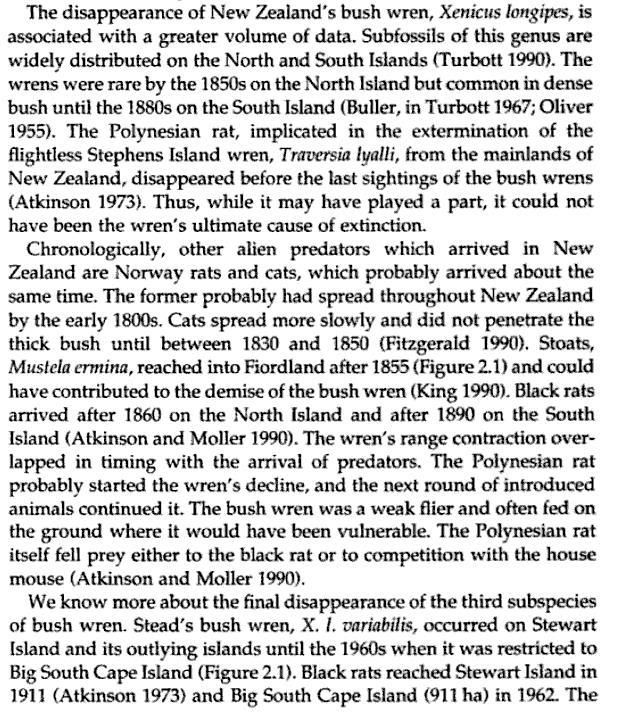 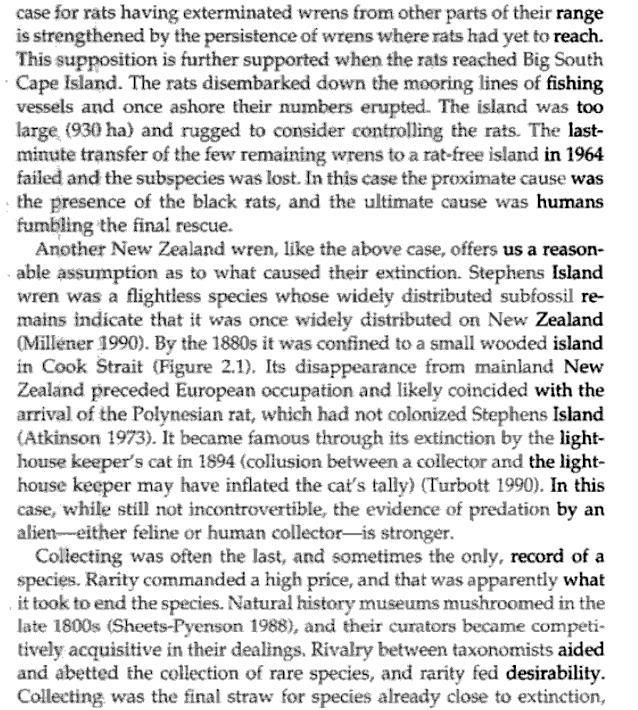 Conservation Biology in Theory and Practice By Graeme Caughley, Anne Gunn |
|
|
|
Post by another specialist on Apr 30, 2009 20:24:02 GMT
|
|
|
|
Post by another specialist on May 3, 2009 19:39:48 GMT
 Encyclopaedia of Birds By Arvind N. Shukla, Rajiv Tyagi |
|
|
|
Post by Melanie on Apr 2, 2012 11:15:05 GMT
|
|
|
|
Post by another specialist on Sept 29, 2012 19:47:39 GMT
|
|
|
|
Post by surroundx on Apr 13, 2015 9:24:16 GMT
|
|
|
|
Post by surroundx on Nov 13, 2016 13:06:17 GMT
Mitchell, K. J., Wood, J. R., Llamas, B., McLenachan, P. A., Kardailsky, O., Paul Scofield, R., Worthy, Trevor H. and Cooper, A. (2016). Ancient mitochondrial genomes clarify the evolutionary history of New Zealand’s enigmatic acanthisittid wrens. Molecular Phylogenetics and Evolution 102: 295-304. |
|